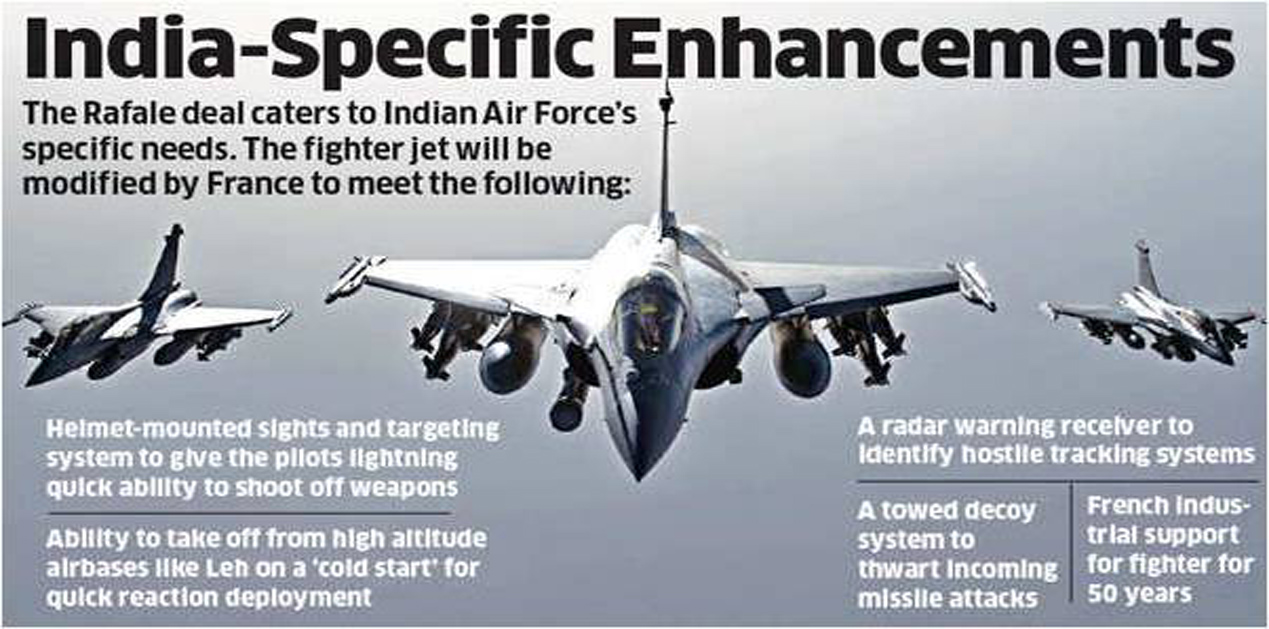In a landmark judgment last week, India’s Supreme Court has summarily dismissed all the petitions challenging the price and propriety of the deal involving the acquisition of 36 Rafale Fighter Jets.1 Declining the petitions, the Supreme Court bench comprising of Chief Justice of India Ranjan Gogoi found no concrete basis for alleged irregularities in the acquisition of 36 fighter jets and noted that “perception of individuals cannot form the basis for interference …and as such…there is no occasion to doubt decision-making process in the Rafale deal”. In delivering the 29-page crisp judgment, the bench also noted that “it is not the job of the court to deal with the comparative details of the pricing” and it wields only narrow judicial ambit to probe the matters of commercial transactions.
Although the petitioners have questioned the court’s wisdom to exercise a limited judicial ambit in probing the deal, in its judgment, the honourable Court made it amply clear that “the scrutiny of the challenges [before us] will have to be made keeping in mind the confines of national security” , and that “the subject of the (defence) procurement is crucial to the nation’s sovereignty.” This view essentially sums-up the basis on which the Court pronounced its verdict and cleared the Rafale deal on all the three counts, namely, pricing, propriety (decision-making process), and the choice of offset partner. On close scrutiny, the view taken by the Court appears to be informed by the prudent practice of strategic procurement and can be best explained by the challenges that import-dependent countries like India face in making the acquisition choices.
Firstly, the late-comer industrializing countries across the global South possess limited industrial and technological capabilities to meet the domestic requirement of complex systems like advance fighter jets. Owing to such limitations, these countries essentially rely on foreign vendors through a combination of ‘buy’ and ‘make’ strategies to acquire advance weapon systems. Additionally, the secondary instruments such as license manufacturing, transfer of technology (ToT), and industrial participation programmes (off-sets), etc. help these countries to acquire know-how and know-why’s associated with high-technology platforms.2 The choice of ‘buy’ and make’ strategies, however, is far from simple than is commonly understood and depends critically on the buyer’s strategic relations with the supplier countries.
The experience of some of the Asian latecomers like South Korea and China is instructive in this context. South Korea, for instance, has been long engaged in the co-production of successive generations of fighter aircrafts with leading American aviation giants owing to its close alliance relationship with the United States. The partnership between the Korean Aerospace Industries (KAI) and the Lockheed Martin (LM) has resulted in the successful development of Korea’s T-50 advance super-sonic jet. 3 China, on the other hand, enjoyed close alliance relations with the Soviet Union only during the first phase of the cold war. After the Sino-Soviet split in the 1970s, China relied upon indigenous (make) development strategies aided by reverse engineering and espionage of foreign technologies and knowledge base.
Secondly, success of licensing and technology partnership depends critically on technological readiness of the local partners. In case of Korea, the better technology readiness and absorptive capacity resulted in the successful development of fifth generation aircrafts whereas in China’s case the failure to close the technology gap has vastly eroded the credibility of its fifth-generation fighter jet programme.
The Indian story is largely similar to this pattern and shows the country’s long-standing dependence on foreign partners to acquire the advance fighter jets. Historically, India’s fighter jet procurements involved a combination of ‘buy & make’ strategies. While the ‘buy’ part involved the direct purchase of limited portion of demand, the ‘make’ part involved indigenous production of remaining quantities through licensing and ToT arrangements. In the past, India has entered into several licensing agreements with former the Soviet Union, France, and Russia for indigenous production of MiG, Mirage and Sukhoi jets respectively.
Procurement of Rafale Jets was also originally modelled along the ‘buy & make’ route involving the direct purchase of 18 fighter jets and the indigenous production of the remaining 108 aircraft under license. This process was initiated by the former UPA government in June 2007, which saw inordinate delays at every stage of procurement starting from issuance of ‘Request for Proposals’ (RFP) to announcement of lowest vendors, and the conclusion of ToT negotiations.4 The key hurdle encountered in this process, which the apex Court highlighted in the judgment, was the stalemate reached over ToT negotiations in which the Hindustan Aeronautics Limited (HAL) demanded 2.7 times the man hours envisaged by French vendor Dassault Aviation.
If accepted, this condition would have led to cost escalation along with and large time-delays in the production. Another issue was the Dassault’s reluctance to provide guarantee for the aircrafts license manufactured by the HAL. In view of such stalemate and also due to the fact that India’s regional adversaries acquired not only 4th but even fifth-generation aircrafts, the Modi Government decided to cancel the eight-year-long RFP process and instead initiated fresh negotiations which led to announcement of new deal for direct purchase of 36 jets in a fly-away condition. The announcement of the new deal, however, triggered a volley of allegations pertaining to procedural irregularity from several members of the opposition and certain spirited citizens.5
The critics, for instance, accused the Government of announcing the new deal well before withdrawing the RFP for the acquisition of 126 fighter jets.6 Such allegations, however, hardly had any merit and the apex Court has rightly labeled them as ‘minor deviations’ which “would not result in either setting aside the contract or requiring detailed scrutiny”. In this context, a number of examples can be cited from the history of India’s defence acquisitions involving major procedural shifts mainly on account of national security imperatives. On several occasions, in the past, the Defence Acquisition Council (DAC) had set-aside the ‘buy & make’ policy preference after extensive negotiations with foreign vendors and instead opted for direct purchase of required quantities of weapons and platforms to meet the immediate requirements of the armed forces.
Such purchases were essentially made through ‘Foreign Military Sales’ (FMS) or Inter-Governmental routes with friendly countries. Although there is no comprehensive data available on India’s off-the-shelf acquisitions in war or peace times, publicly-available information can suffice to provide a qualitative assessment on procedural shifts as transpired in case of the Rafale deal. During the Kargil War, for instance, the Indian Army imported large quantities of mortar and ammunition from Israel. At the peak of the conflict, Israel also promptly provided India with laser-guided missiles for the Mirage Jets.7
Similarly, during the peacetime, the Indian Air Force made the direct purchase of 19 Low-Level Transportable Radars (LLTR) after the failure to negotiate ToT agreement with the foreign vendor on four different occasions. To meet the immediate requirements of IAF, the DAC had accorded Acceptance of Necessity to directly import 19 LLTRs at a cost of 1272 crore in October 2005.8 The purchase of P3C-Orion and the heavy lift transport aircraft through FMS route which ran into several billions also provide good examples of India’s choices in acquiring the complex aviation platforms. While the aforementioned cases are few and may not compare well with 58000 Crore deal involving 36 Rafale Jets, these are emblematic of the complexities involved in the acquisition of advance military platforms which the critics of Rafale deal have chosen to ignore willingly or unwillingly.
Apart from the procedural issues, the Court has also set the record straight on allegations of escalated price and the choice of offset partner in the new deal. On price issue, the judgment establishes the facts that the deal finalized by the BJP government not only delivers ‘value for money’ but also displays enormous efficiency wherein the government concluded complex negotiations in a span of merely two and half years. The ‘value for money’ in the deal is also evident from acquisition of a number of additional capabilities which the previous negotiations did not even envisage.9
Similarly, on the choice of off-set partner, the Court found no substantial evidence on allegations of ‘winner-picking’ by the Government and that the Reliance Defence Limited (RDL) was one of several partners along with the Defence Research and Development Organization (DRDO). Secondly, the RDL will not be involved in Rafale manufacture since all the 36 jets are bring bought in a fly-away condition. In this regard, the Court merely reiterated the country’s offset policy wherein the right to choose the local industry partner rests with the foreign vendor and not the Indian Government. The judgment further observed that it is neither appropriate nor within the experience of the Court to step into this arena of what is technically feasible or not.
In conclusion therefore, by dismissing the petitions on Rafale deal, the apex Court has set an important precedent for all the future military acquisitions where vital national security interests are at stake.
References:
- See, Indian Supreme Court at:
https://www.sci.gov.in/supremecourt/2018/32813/32813_2018_Judgement_14-Dec-2018.pdf - Kevin A. Desouza (2017): Transfer of Defence Technology: Exploring the Avenues for India, Journal of Defence Studies, Vol. 11, No. 3, July-September 2017, pp. 69-98.
- Chris Pocock, KAI Unveils T-X Contender, Pursues T-50 Exports, ainonline, December 18, 2015, at https://www.ainonline.com/aviation-news/defense/2015-12-18/kai-unveils-t-x-contender-pursues-t-50-exports
- The Court Judgement gives the chronology of events in the run-up to announcement of new deal which shows significant times elapsed between various phases of procurement o 126 jets.
- The first part of the judgment summarizes each petition and its concerns via-s-vis the procurement of 36 jets.
- Modi Should Explain How Rafale Deal Went From '95% Complete' to Zero in Two Weeks, The Wire, at: https://thewire.in/government/rafale-deal-modi-must-use-opportunity-clear-air-transparent
- NICOLAS BLAREL, Planes, Drones, Missiles: How Kargil changed Indo–Israeli Relations, 18 January 2015 https://caravanmagazine.in/vantage/planes-drones-missiles-kargil-indo-israeli-relations
- Execution of Mission Mode Projects and delivery of systems by DRDO, Report No. 38 of 2015 (Air Force), URL: https://cag.gov.in/sites/default/files/audit_report_files/Union_Compliance_Defence_Air_Force_Report_38_2015_chap_3.pdf
- Abhijit Iyer-Mitra, The plane truth about Rafale deal is so hard to see?, Economic Times, February 15, 2018, at:http://economictimes.indiatimes.com/articleshow/62937909.cms?utm_source=contentofinterest&utm_medium=text&utm_campaign=cppst
Image Source: https://img.etimg.com/photo/54490955/rafale-1.jpg










Post new comment